If you’re looking for the most foolproof, quick, easy, perfect scrambled eggs recipe, this is it! This recipe makes perfectly fluffy and creamy scrambled eggs in just 1 minute!
Tired of whisking and stirring eggs forever to achieve elusive perfect scrambled eggs? Well, worry no more!
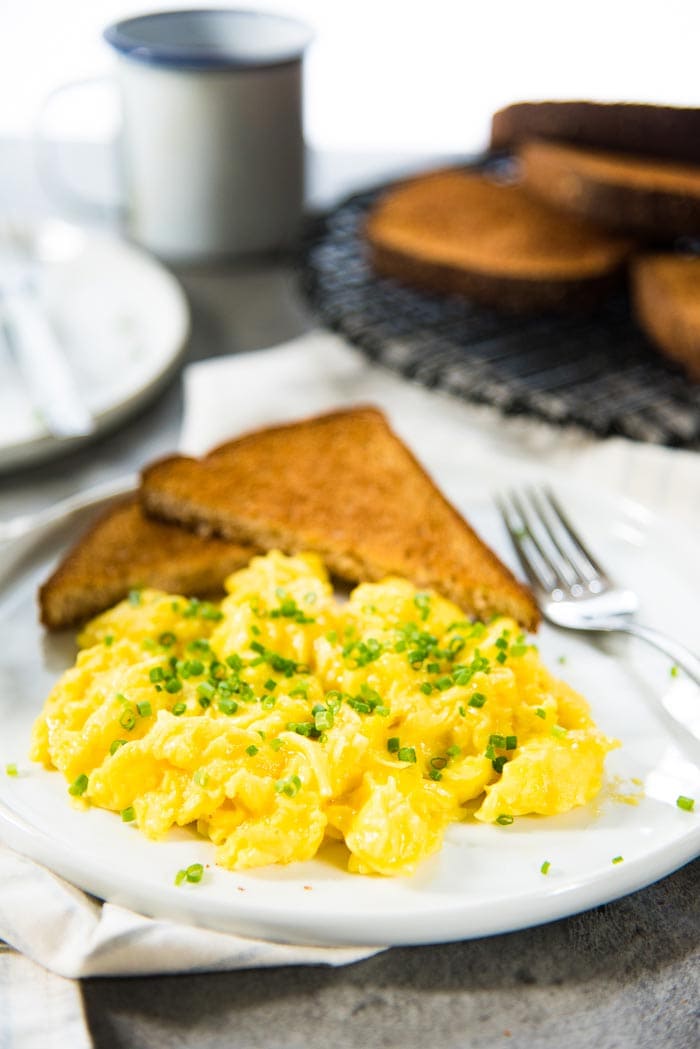
Eggs are a quintessential part of breakfast for me. From my French toast recipe to breakfast fried rice, egg in a hole, oven roasted breakfast potato hash, pizza egg muffins, bacon and egg pie, egg stuffed breakfast scones, classic quiche lorraine etc., eggs feature heavily in our breakfast and brunch menu.
(See here for more recipes that use eggs and breakfast recipes for lots more ideas!)
Scrambled eggs
Scrambled eggs often get a bad rap. It’s hard to nail it, it needs to be cooked slowly, and at low temperature. Otherwise, you risk having the eggs taste bland and rubbery, and worse still, you end up with the eggs separated.
There are so many rules to follow to make PERFECT scrambled eggs, when it should be something so simple to make, wouldn’t you agree?
And here’s the thing. I’ve been eating fluffy, creamy, delicious scrambled eggs for years with no issues! And I break most of the rules.

Why this is the most foolproof scrambled eggs recipe
This recipe will give you perfect scrambled eggs that are,
- Creamy
- Fluffy
- Fast (faster than any other classic scrambled eggs recipe)
- Foolproof and easy
- Adaptable
With this foolproof recipe, you can make 2 servings of perfect scrambled eggs in 1 minute.
Plus, you can easily make multiple batches in the same time that it would take you to make slowly cooked “classic” scrambled eggs.
And it’s all thanks to one secret ingredient!
My secret ingredient for the best scrambled eggs
This recipe for perfect, creamy, fluffy scrambled eggs is one my mom taught me when I was 8 years old, and I’ve been making it that way ever since.
That ONE SECRET INGREDIENT that makes this recipe work perfectly every time – cornstarch!
I used to wonder why she added cornstarch to her scrambled eggs, but it always made the recipe foolproof and easy, even for an 8 year old!
Since I first published this recipe, I’ve found that instant clearjel also works perfectly for this recipe. Maybe even better than cornstarch. But I still make this recipe with cornstarch 90% of the time since it’s more readily available.
Scrambled eggs ingredients

- Eggs – Crucial to use good quality eggs. Good eggs are ones that you like the taste of – that’s it. You don’t have to purchase free range, organic eggs, if regular eggs are just as fine for you. And if you’re able to, always use the most fresh eggs possible. (I often use the simple egg float test to determine the freshness of eggs.)
- Milk or cream – Yes! I add liquid to my eggs. It makes the scrambled eggs so creamy. Cream adds more richness, but milk can be used too.
- Cornstarch – My secret ingredient! If you have access to it, Instant ClearJel (modified cornstarch) also works really well, since it’s immediately activated when mixed with liquid.
- Salt – Crucial for flavor. Without salt, the eggs will taste bland.
- Butter – This is to cook the scrambled eggs. Butter adds another layer of flavor, but you can also use olive oil or vegetable oil.
- Black pepper – Optional, but you can add black pepper to the eggs OR sprinkle it on top after cooking the eggs.
Rules of making classic scrambled eggs
First, rules that I like to break.
Rule 1 – Cook the eggs on low heat
Well, screw that. I cook my scrambled eggs on medium-high heat, and still get perfect scrambled eggs, every time. With this recipe, you can make scrambled eggs on a higher heat OR a lower heat and still get delicious, creamy and fluffy scrambled eggs!
Rule 2 – Don’t add any liquid
The fact is if you do cook your scrambled eggs at a low temp., then you won’t need any extra liquid anyway.
But my foolproof, perfect scrambled eggs do use milk (or cream) to add delicious creaminess!
And don’t worry, there’s NEVER any separation of the eggs with this recipe, or any dilution of flavor.
Next up, rules I agree with.
Rule 3 – Whisk the eggs very well first
I agree with this rule, but there’s one caveat. I prefer to BLEND my eggs rather than whisk.
When you whisk with a fork, the egg yolk is mixed in with the white, but parts of the white still remain intact.
And then when you cook this egg, you end up with uneven, white rubbery bits in your scrambled eggs, which prevents your scrambled eggs from being uniformly creamy. Blending the eggs (I use a stick blender, but you can use a regular blender too), helps you easily avoid this unappetizing problem.
Briefly blending the eggs results in a creamier texture because this aerates your eggs more, evenly mixing the egg yolk with the white. So, you end up with even more fluffy and creamy eggs!
BUT, if you don’t have a blender for this purpose, you can still achieve the same result by whisking the eggs REALLY well by hand and then quickly passing the whisked eggs through a sieve to remove any unmixed egg whites.
But of course, this takes longer and isn’t as convenient as using a blender.
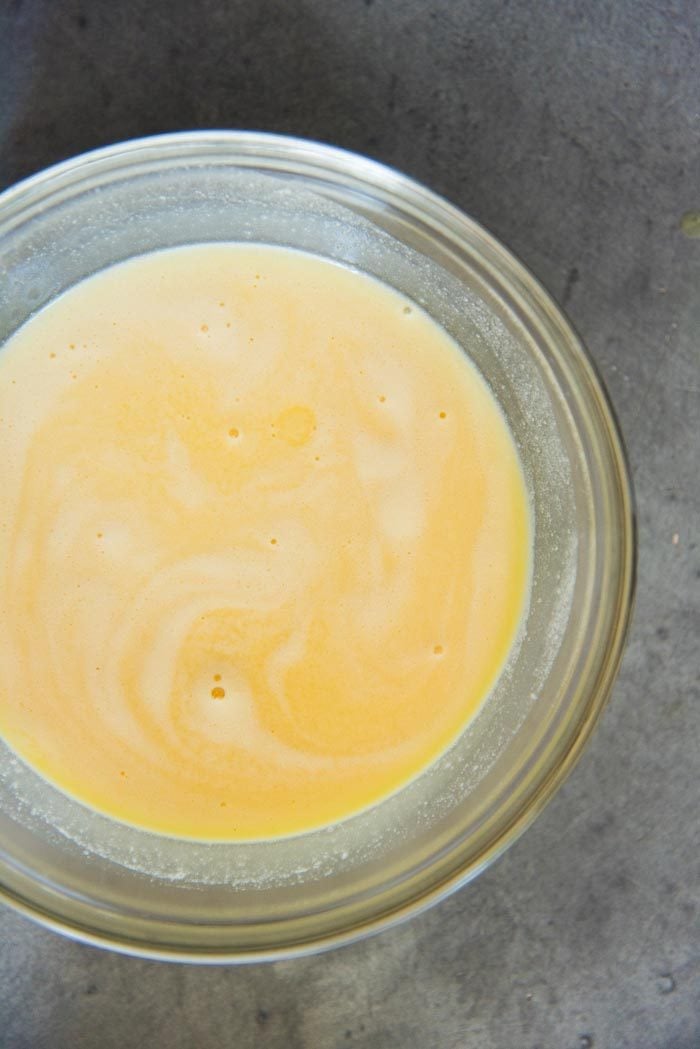
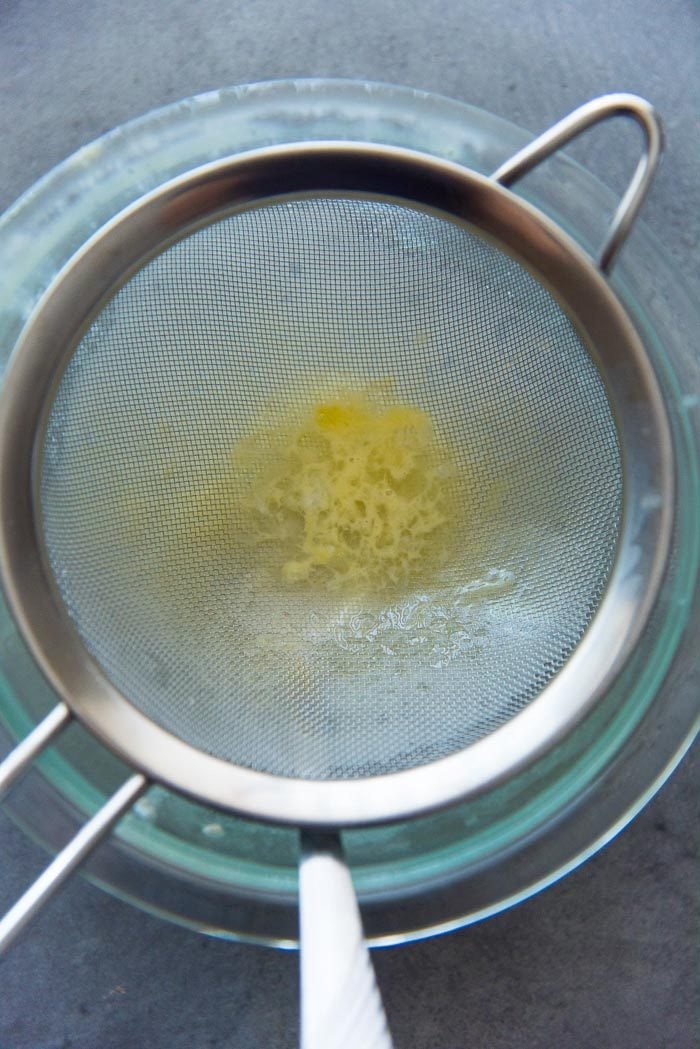
Rule 4 – Don’t stop mixing while your eggs are cooking
This is especially true for this recipe, because we are cooking the scrambled eggs at a higher temperature here. So, you need to keep the eggs moving with a rubber spatula or wooden spoon to make sure they cook evenly.
Because the heat is higher, once the eggs start to set, you can even let the scrambled eggs continue to cook on residual heat while you keep mixing the curds.
The other trick to getting perfect scrambled eggs is to remove the eggs from the heat WHILE they are still a little wet, because the eggs will continue to cook for a bit longer.
Rule 5 – Pre-salting (adding salt to raw eggs first)
Some recipes call for the scrambled eggs to be salted AFTER cooking. This is because salting the eggs can cause the proteins in the eggs to be held in tighter and resulting in liquid oozing out of the curds as the scrambled eggs sit.
However, this can be avoided if the eggs are cooked on low heat.
The case for salting beaten eggs before cooking is simply for flavor! The salt has the chance to season the entire egg mixture making sure to evenly season the scrambled eggs.
How cornstarch works in this recipe
Cornstarch expands in the presence of liquid and heat and forms a starchy network. It works in 2 ways to ensure perfect, fluffy scrambled eggs.
- Acts as a buffer for the eggs against high heat and cooking too fast.
- Forms a protective network or scaffold that holds your eggs together and prevents them from separating.
This is also true for Instant ClearJel, which is modified cornstarch (no cook type), as the starchy network expands in the presence of liquid even without heat.
Who wants to keep stirring eggs forever on a lazy Sunday morning for those elusive, perfect scrambled eggs? Well, they are not so elusive anymore!
How to make scrambled eggs

Step one
Take a big bowl or a jug and add the milk or cream, along with the cornstarch. You need a big bowl because you need enough room to blend the eggs with a stick blender, or whisk the eggs VERY well with a large whisk.
Stir to dissolve the cornstarch and milk until there are no lumps (image 1).

Step two
Then add the eggs and salt to the cornstarch mix and blend or whisk very well. The egg mixture should be really loose and the egg white lumps should be separated and liquidy (image 2).
If needed, pass the egg mixture through a sieve to get rid of any lumps and to break up the egg whites. If you like, you can add black pepper at this stage too, or add it at the end.
Have your plates and serving sides ready to go before you start making the scrambled eggs.

Step three
Heat your nonstick pan or nonstick skillet over medium – medium high heat. When the non-stick pan is hot, add the butter and use a flexible spatula (like a silicone spatula) to spread the butter on the bottom of the pan (image 3).
Don’t let the butter burn, if you want your scrambled eggs to have a light color (no brown spots).
Step four
Immediately add the egg mixture (image 4). The butter does not need to be completely melted. As soon as you add the egg mixture, use the spatula to mix the eggs to break up the egg curds. Starting from the outside, moving towards the middle of the pan.
A few seconds in, the egg curds will start to be more visible as you move the egg mixture (image 5).
If the eggs are setting too quickly, remove the pan from the heat and mix them off the heat. The residual heat will continue to cook and set the eggs.

Transfer the eggs to the plate just before the eggs are at your desired consistency. I like my eggs to be very creamy and just barely set, so I make sure my scrambled eggs aren’t completely set before transferring them to my plate (image 6).
If you prefer dry scrambled eggs, you can cook them for a few seconds more to ensure the curds are set before plating them.
Top the eggs with black pepper and chopped herbs (like fresh dill or fresh chives) and serve with toast!
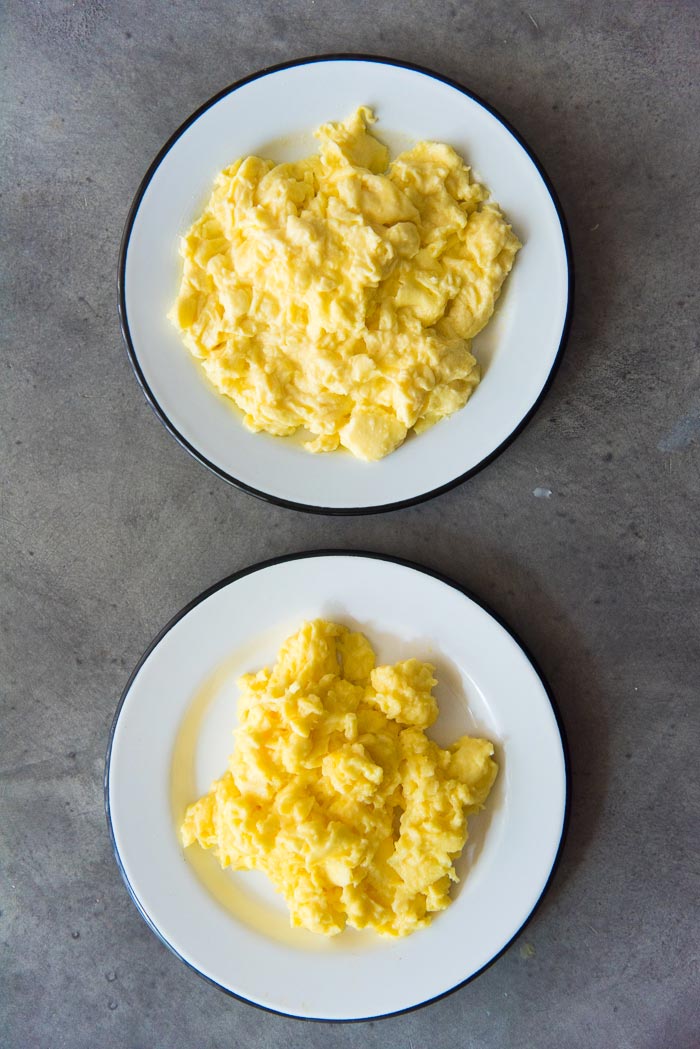
My best recipe tips
- Use cornstarch or instant clearjel. This addition prevents the scrambled eggs from weeping after cooking and you won’t find a pool of liquid underneath the scrambled eggs.
- Blending the eggs will make the eggs super fluffy because the protein structures are broken and air is incorporated into the mixture to make it fluffier and creamier.
- Keep moving the eggs as you’re cooking them because the eggs will set as soon as they hit the hot pan (vs cooking on low heat).
- Remove the eggs from the pan just before the eggs are at the desired consistency. Residual heat will further continue to cook the eggs a little.
- Have the toast and other toppings ready to go BEFORE cooking the eggs. So you can serve the scrambled eggs immediately after cooking. The longer the scrambled eggs sit, the more they will dry out.

How to upgrade your scrambled eggs
This scrambled egg recipe is excellent on its own, but it’s also very adaptable! Because of the addition of milk or cream, these scrambled eggs are very creamy.
You can add all kinds of additions for more flavor! Here are some of my favorite ways to dress up this recipe.
- Fried bacon mixed with scrambled eggs.
- Ham and cheese scrambled eggs.
- Spinach scrambled eggs – Sautéed spinach (with some garlic) mixed with scrambled eggs (or use kale or other leafy greens).
- Tomato scrambled eggs – Tomatoes chopped and cooked down with spices and basil, and mixed with scrambled eggs.
- Salami or other deli meats.
- Cheese and herbs for cheesy scrambled eggs. Or use feta to make a feta scrambled eggs for a salty kick!
- Cream cheese – To add a tangy, creamy flavor.
- Ricotta scrambled eggs – For super milky and creamy scrambled eggs.
- Cottage cheese scrambled eggs – This will add more protein to your scrambled eggs. If you like the texture of cottage cheese, you can just add the cottage cheese as is. But if you’re like me, and you don’t like the texture of cottage cheese, you can blend it with the eggs before scrambling the eggs.
- Add sautéed or leftover roasted vegetables to make veggie scrambled eggs. I like adding peppers, potatoes, broccoli or sweet potatoes.
- Serve scrambled eggs with cubed avocado, or on top of avocado toast for avocado scrambled eggs.
- Add other spice mixes,
- Garam masala, onions, chili, and curry leaves
- Soy sauce
- Dashi stock, togarashi and spring onions
- Fajita or taco seasoning
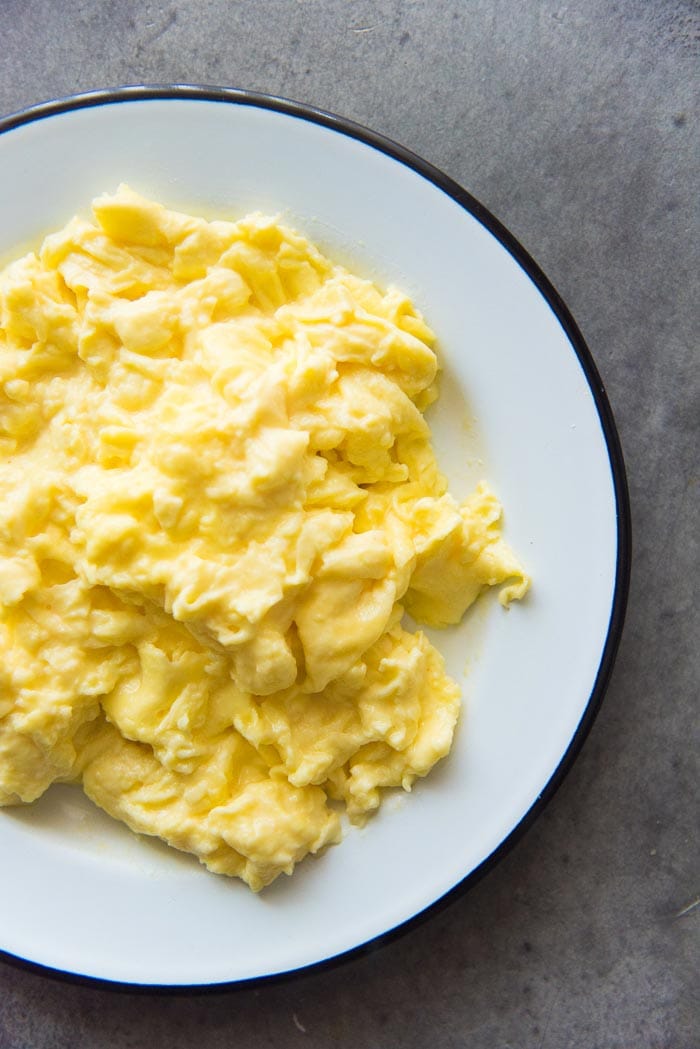
Serving ideas
- On buttered toast
- Sandwiches made with white bread, brioche bread, Japanese milk bread etc.
- In breakfast burritos or breakfast tacos
- On a bed of white rice or brown rice
- With toasted bagels
- With French croissants
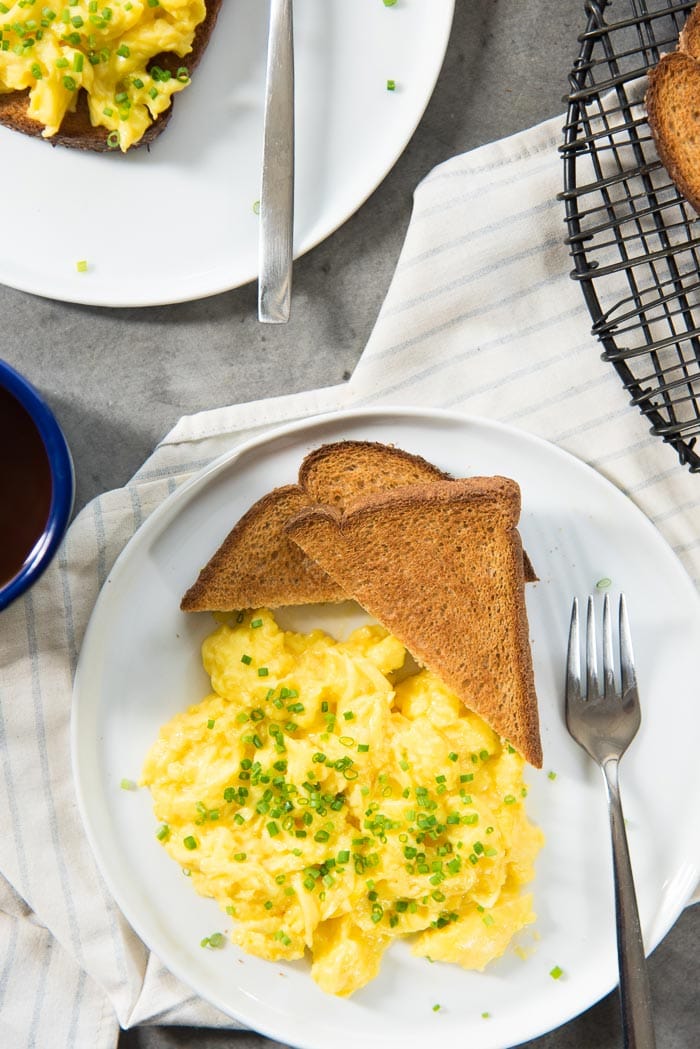
Commonly asked questions
This is a question I get asked surprisingly often because I have two dogs. Yes, I feed my dogs scrambled eggs often! But, I do make some changes to the recipe.
For dog-friendly scrambled eggs, do not add any salt, or any cream or milk either.
Ideally I wouldn’t add any butter either, or just very little oil. Then cook the whisked eggs until the eggs are set and cooked through. Let it cool down and then you’re good to go.
However, I do highly recommend consulting a vet first to make sure eggs are safe for your dog to eat, because some dogs may have unique gastrointestinal sensitivities. In the meantime, you can also check out my homemade dog cake for another special occasion-worthy dog treat!
Yes, you can! Ideally though I recommend freezing omelets instead of scrambled eggs if you really want to freeze cooked eggs for later.
Portions of scrambled eggs can be stored in airtight containers and then in the freezer. To eat, thaw out the scrambled eggs in the fridge overnight first. Then it can be reheated in the microwave at a lower power for a longer time to ensure that the eggs reheat evenly.
However, the risk of reheating scrambled eggs is that they can dry out and will not have the same texture. Which is why I recommend freezing omelets instead.
As mentioned above, I prefer not to make scrambled eggs in advance because the texture will change as they are reheated.
However if you need to reheat scrambled eggs, the best way is to cover the eggs with a damp paper towel, and then reheat for a few minutes at 50% power or lower until heated through.
Please see the section above on how to upgrade your eggs for a list of different additions you can add to make your eggs taste even better.
More egg recipes you’ll love
- Ramen eggs
- Asian deviled eggs
- Classic quiche lorraine
- Japanese egg sandwich
- Egg in a hole
- Baked eggs (shirred eggs)
- Pizza egg muffins
- Bacon and egg pie
- Egg stuffed breakfast biscuits
- Sausage frittata
- Breakfast scotch eggs
Looking for more recipes?Sign up for my free recipe newsletter to get new recipes in your inbox each week! Find me sharing more inspiration on Pinterest and Instagram.
Perfect Scrambled Eggs (1 minute scrambled eggs)
Ingredients:
- 4 large eggs fresh eggs are better
- 2 tbsp milk or cream (I personally prefer cream)
- ¾ tsp cornstarch or Instant ClearJel (about 2.5 g)
- ½ tsp sea salt adjust to your taste
- 1 ½ tbsp butter or oil (for cooking)
To serve
- Cracked black pepper optional
- Chopped chives optional
Instructions:
- Place an 8 inch non-stick pan on the stove, and turn up the heat to medium to medium-high.
- Add the cornstarch and milk into a big bowl or jug. Whisk to dissolve the cornstarch in the milk.2 tbsp milk, ¾ tsp cornstarch
- Crack the eggs into the milk and add the salt. Blend the egg mixture with a stick blender. OR whisk it really well with a whisk or fork.4 large eggs, ½ tsp sea salt
- If you whisked with a whisk or fork, pass the eggs through a sieve to remove any lumps (this is an optional step, but it helps to make the eggs fluffier and creamier).
- When the cooking pan is hot, add the butter to the pan and swirl to coat the pan.1 ½ tbsp butter
- Immediately add the eggs into the pan (before or as soon as the butter has melted – don't let the butter cook too long and turn brown – see recipe notes).
- Using a spatula, immediately start to stir the eggs from the outside in. Stir slowly, but continuously, to break the egg curds that are forming in the pan. If you feel the eggs are cooking too fast, remove the pan from the heat and continue to stir and mix the eggs. The eggs should be done in 1 minute.
- Remove the eggs from the pan while the eggs are still a little wetter than the consistency you prefer. This is because the eggs will continue to cook for a bit longer in residual heat.
- Divide the eggs into two portions and sprinkle with either black pepper, chives, or both. Serve with buttered toast.Cracked black pepper, Chopped chives
Tips & Tricks
A note about the cornstarch
These eggs do not come out starchy because there is very little cornstarch. However, you can reduce the heat a little to cook the eggs slightly slower. OR use Instant ClearJel which does not require to be heated to activate the thickening.A note about preventing overcooked eggs
If you have trouble taking the eggs off the heat before it overcooks, then I recommend, making sure that you’re constantly moving the eggs around in the pan as soon as they are added to the pan. OR reducing the heat so you have better control over the consistency of the cooked eggs.A note about butter
The reason why I recommend not letting the butter brown is so that the eggs have no color in them. That being said, it is ABSOLUTELY OK to let the butter melt and brown slightly (without turning dark brown and burning). Butter that has browned in this way is essentially brown butter and will add more flavor to your scrambled eggs, but will add color to the eggs too.Nutrition Information:
“This website provides approximate nutrition information for convenience and as a courtesy only. Nutrition data is gathered primarily from the USDA Food Composition Database, whenever available, or otherwise other online calculators.”

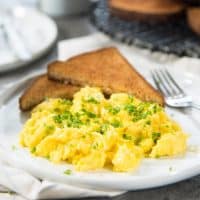
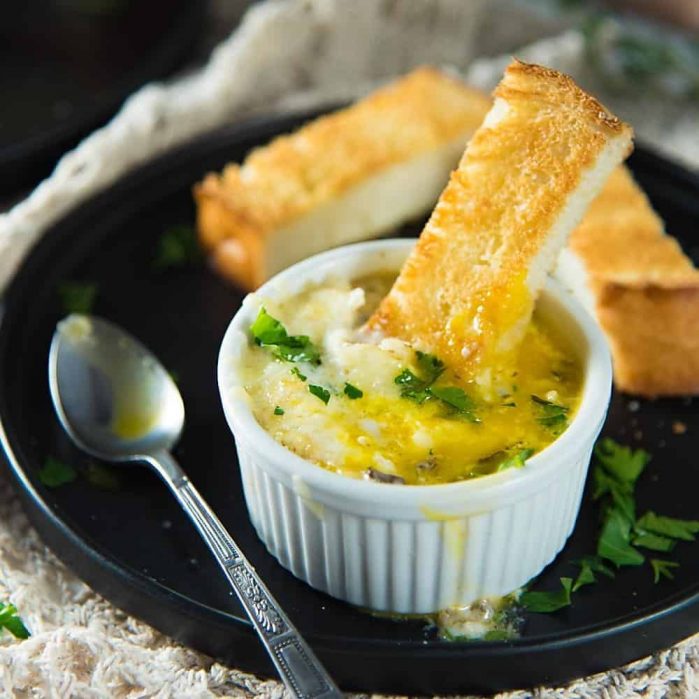
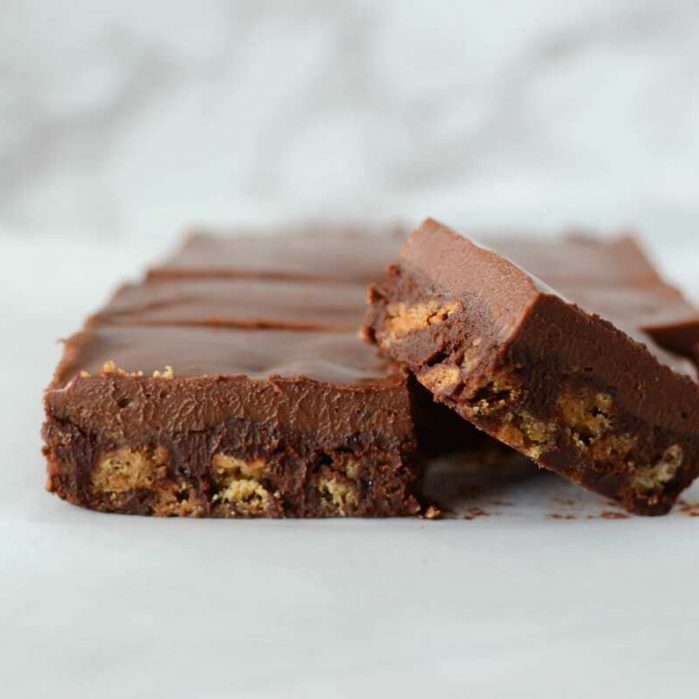
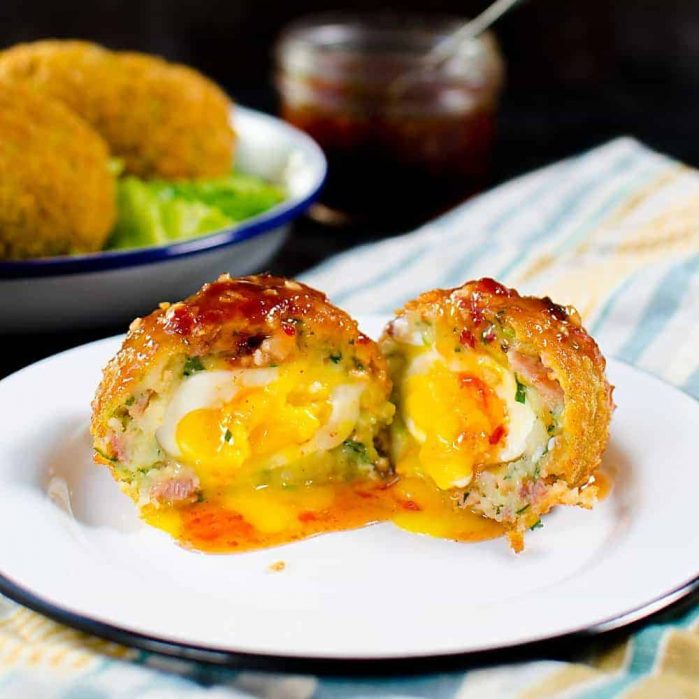
Nora says
It’s a great recipe and it makes the best scrambled eggs.